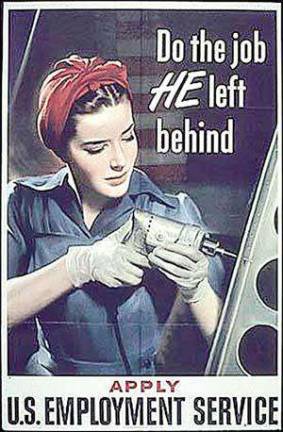“In May of 1945 we were in Okinawa. General quarters banged and two kamikazes hit us at the same time. These were Japanese suicide pilots that dived their planes right into the target.” These are the written words of a sailor who served on the aircraft carrier Bunker Hill during World War II. Survivors were picked up by the S.S. Sullivan, but 495 men were killed in that attack. These, and all those who lost their lives serving our country, are who we honor on Memorial Day. During World War II American civilians also played an active role. From factory workers to plane spotters, Americans stood behind the military and sought to protect their homeland. The onset and the numbers World War II began in Europe when Germany invaded Poland in 1939. The United States declared war on Japan immediately following the devastating attack on Pearl Harbor on Dec. 7, 1941. Over the next four years 16 million men and women served in the United States military. It is estimated that 50-70 million people died in World War II, with America losing 291,557 military members in battle deaths. Rationing and scarcity The posters read “Do with less so they’ll have enough.” The economy shifted to war production and by 1942 the Food Rationing Program was in effect, followed by a price freeze. Basically food shortages were due to the lack of manpower and transportation and the abundance of provisions being shipped to the military and allied civilians. Ration books were issued to each American. The list of rationed items grew: cars, typewriters, sugar, bicycles, fuel oil, silk, nylon, coffee, stoves, meat, lard, oils, cheese, butter, margarine, bananas, tea, canned milk, firewood and coal. Even shoes were rationed because of their precious leather soles. By 1942 gas was restricted to four gallons a week, affecting 27 million non-essential passenger cars. Attacks on United States Geographically separated from the enemy, attacks were rare but did occur: Japanese submarines shelled an oil refinery in California; several ships were torpedoed by Japanese submarines within sight of the West Coast; Fort Stevens in Oregon was shelled; a Japanese seaplane dropped incendiary bombs in Oregon; the Japanese launched 9,000 fire balloons into the Pacific jet stream with 300 reaching North America, six people in Oregon died; German U-Boats dispatched teams on Long Island, near Jacksonville, Fla., and in Maine. Other than the six deaths, minimal damage was incurred. Unemployment, women in work force In 1939 the unemployment rate was 17.2 percent, dropping to 1.2 percent by 1944. Stepped-up wartime production created millions of new jobs and women joined the labor force to replace the men. “Rosie the Riveter” became the symbol of women in manufacturing. In some areas schools closed at harvest time so students could work the farms. By 1943 three million teenagers worked in fields and factories. “Do the job HE left behind” posters propelled women into the work force. Victory Gardens Back yards and vacant lots became Victory Gardens, with 20 million tracts growing 40 percent of vegetables consumed in America. The “You Too Can Serve” campaign promoted gardening and preserving as patriotic acts. Citizen’s efforts and War Bonds Recycling is not new. “I’m in this fight, TOO” and “Get into the scrap” slogans urged Americans to recycle rubber, tin, waste kitchen fats (for explosives), paper, lumber, steel, old tires, even bathing caps and raincoats. Abandoned railroad tracks were torn up for steel and children made rubber band balls and foil balls from gum wrappers. Consumer spending was discouraged and the sale of war bonds netted billions of dollars for the war chest. The public paid three-quarters of the face value of the bond with the promise of full face value to be paid after a set number of years. The government never defaulted on payment of mature bonds. Faces of war On April 12, 1945 President Franklin Delano Roosevelt died and Vice President Harry Truman took office. On April 28 Benito Mussolini was tried and executed by partisan Italians; on April 30 Adolph Hitler committed suicide. On May 8, 1945 Germany surrendered. On board the battleship Missouri on Sept. 2, General Douglas MacArthur accepted the formal surrender from Japan. After four years and countless sacrifices the war was over. Life returned to normal in America. “All we have of freedom, all we use or know - This our fathers bought for us long and long ago.” Rudyard Kipling Sources: http://en.wikipedia.org; Congressional Research Service; www.americanhistoricalsociety.org; www.answers.com www.u-s-history.com; www.militarymuseum.org; G.McMahon, family letter; www.about.com; www.ameshistoricalsociety.org; “Chronicle of the Twentieth Century”
